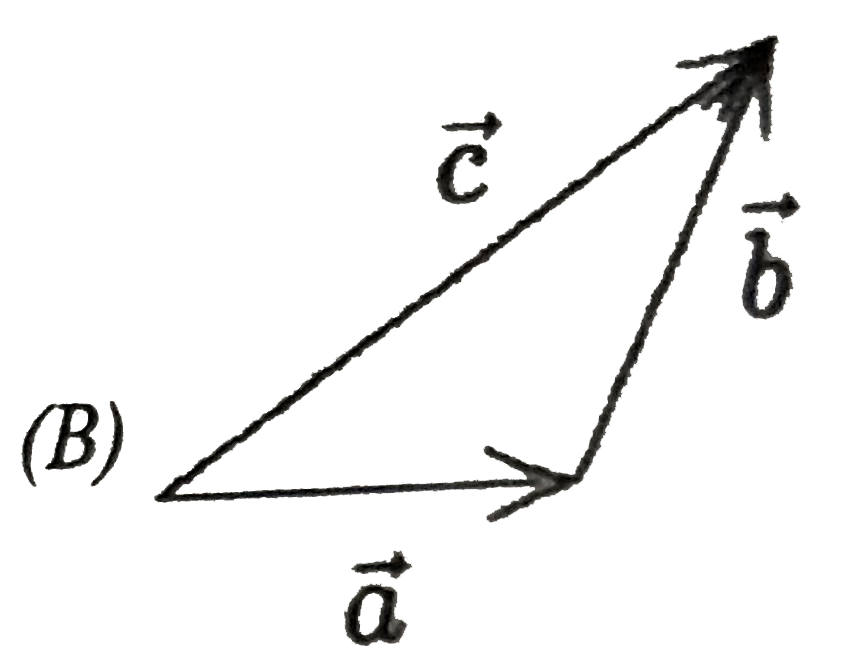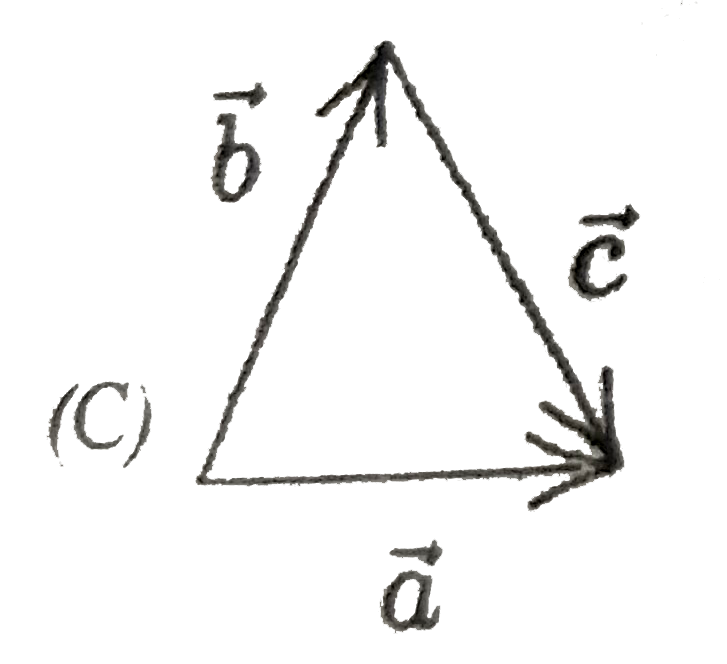The vectors →a,→band→c are related by →c=→a+→b . Which diagram below illustrates this relationship ?




The correct Answer is:B
To solve the problem, we need to analyze the relationship given by the equation →c=→a+→b and determine which diagram correctly represents this vector relationship.
1. Understanding the Vector Addition:
- The equation →c=→a+→b indicates that vector →c is the resultant of adding vectors →a and →b.
- In vector addition, the tail of the second vector (in this case, →b) should start from the head of the first vector (here, →a).
2. Analyzing Diagram A:
- In Diagram A, if we start from the tail of →a, it appears that →b starts from the head of →a, but the resultant →c does not start from the head of →b.
- This does not satisfy the relationship →c=→a+→b.
- Conclusion: Diagram A is incorrect.
3. Analyzing Diagram B:
- In Diagram B, starting from the tail of →a, we see that →b starts from the head of →a.
- The head of →b then represents the head of →c.
- This correctly illustrates that →c is the resultant of →a and →b.
- Conclusion: Diagram B is correct.
4. Analyzing Diagram C:
- In Diagram C, if we start from the tail of →b and then move to →c, we find that this configuration implies →a is not correctly represented as the sum of →b and →c.
- This does not satisfy the relationship →c=→a+→b.
- Conclusion: Diagram C is incorrect.
5. Analyzing Diagram D:
- In Diagram D, similar to Diagram C, the arrangement does not show →c as the resultant of →a and →b.
- This also does not satisfy the relationship →c=→a+→b.
- Conclusion: Diagram D is incorrect.
Final Answer:
The correct diagram that illustrates the relationship →c=→a+→b is Diagram B.
- The equation →c=→a+→b indicates that vector →c is the resultant of adding vectors →a and →b.
- In vector addition, the tail of the second vector (in this case, →b) should start from the head of the first vector (here, →a).
- In Diagram A, if we start from the tail of →a, it appears that →b starts from the head of →a, but the resultant →c does not start from the head of →b.
- This does not satisfy the relationship →c=→a+→b.
- Conclusion: Diagram A is incorrect.
- In Diagram B, starting from the tail of →a, we see that →b starts from the head of →a.
- The head of →b then represents the head of →c.
- This correctly illustrates that →c is the resultant of →a and →b.
- Conclusion: Diagram B is correct.
- In Diagram C, if we start from the tail of →b and then move to →c, we find that this configuration implies →a is not correctly represented as the sum of →b and →c.
- This does not satisfy the relationship →c=→a+→b.
- Conclusion: Diagram C is incorrect.
- In Diagram D, similar to Diagram C, the arrangement does not show →c as the resultant of →a and →b.
- This also does not satisfy the relationship →c=→a+→b.
- Conclusion: Diagram D is incorrect.
The correct diagram that illustrates the relationship →c=→a+→b is Diagram B.
Topper's Solved these Questions
- UNIT DIMENSION, VECTOR & BASIC MATHSBook:BANSALChapter:UNIT DIMENSION, VECTOR & BASIC MATHSExercise:Solved Example
Explore 17 Videos
- UNIT DIMENSION, VECTOR & BASIC MATHSBook:BANSALChapter:UNIT DIMENSION, VECTOR & BASIC MATHSExercise:PRACTICE EXERCISE
Explore 4 Videos
- KINETIC THEORY OF GASESBook:BANSALChapter:KINETIC THEORY OF GASESExercise:Section-B
Explore 13 Videos
Similar Questions
Knowledge Check
Three vector →A,→B, →C satisfy the relation →A⋅→B=0and →A.→C=0. The vector →A is parallel to
A→BB→CC→B.→CD→B×→CThe vectors →a,→b,→cand→d are such that →a×→b=→c×→dand→a×→c=→b×→d. Which of the following is/are correct?
1. (→a−→d)×(→b−→c)=→0
2. (→a×→b)×(→c×→d)=→0
Select the correct answer using the codes given belowAA. Only 1BB. Only 2CC. Both 1 and 2DD. Neither 1 nor 2If →A,→B and →C are three vectors, then the wrong relation is :
A→A+(→B+→C)=(→A+→B)+→CB→A.(→B+→C)=(→A.→B)+→A.→CC→A×(→B+→C)=→A×→B+→A×→CD(→A×→B).→C=→A×→B.→C
Let three vectors →a,→b and →c be such that →a×→b=→c,→b×→c=→a and |→a|=2. Then which one of the following is not true ?
View Solution[→a→b→c]=[→b→c→a]=[→c→a→b].
View SolutionThree vectors →A,→B and →C are related as →A+→B=→C .If vector →C is perpendicular to vector →A and the magnitude of →C is equal to the magnitude of →A, what will be the angle between vectors →A and →B.
View SolutionShow that the vectors →a, →b and →c are coplanar if →a+→b, →b+→c and →c+→a are coplanar.
View SolutionShow that the vectors →a,→b and→c are coplanar if →a+→b,→b+→c and →c+→a are coplanar.
View Solution

